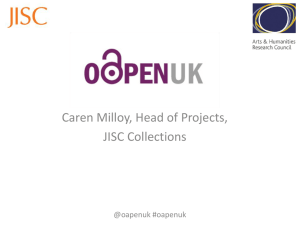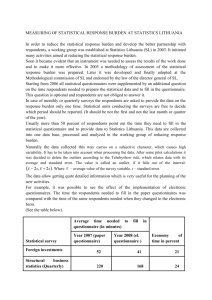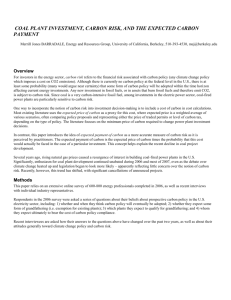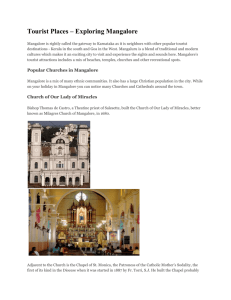Sudha_Commerce - University College Mangalore
advertisement
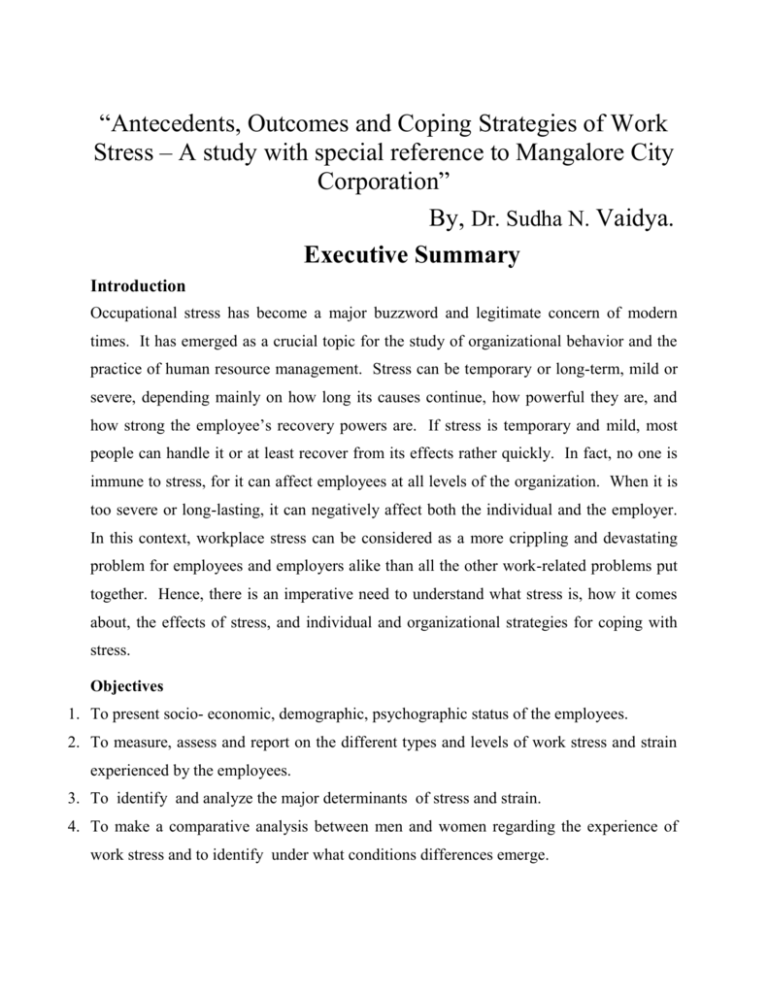
“Antecedents, Outcomes and Coping Strategies of Work Stress – A study with special reference to Mangalore City Corporation” By, Dr. Sudha N. Vaidya. Executive Summary Introduction Occupational stress has become a major buzzword and legitimate concern of modern times. It has emerged as a crucial topic for the study of organizational behavior and the practice of human resource management. Stress can be temporary or long-term, mild or severe, depending mainly on how long its causes continue, how powerful they are, and how strong the employee’s recovery powers are. If stress is temporary and mild, most people can handle it or at least recover from its effects rather quickly. In fact, no one is immune to stress, for it can affect employees at all levels of the organization. When it is too severe or long-lasting, it can negatively affect both the individual and the employer. In this context, workplace stress can be considered as a more crippling and devastating problem for employees and employers alike than all the other work-related problems put together. Hence, there is an imperative need to understand what stress is, how it comes about, the effects of stress, and individual and organizational strategies for coping with stress. Objectives 1. To present socio- economic, demographic, psychographic status of the employees. 2. To measure, assess and report on the different types and levels of work stress and strain experienced by the employees. 3. To identify and analyze the major determinants of stress and strain. 4. To make a comparative analysis between men and women regarding the experience of work stress and to identify under what conditions differences emerge. 5. To rise important organizational and managerial implications based on the findings of the study. This study “Antecedents, outcomes and coping strategies of work stress- A study with special reference to Mangalore City Corporation” will be based on the data collected from the employees(male/female) of the office of the Mangalore City Corporation. The unit selected for the study is “Mangalore City Corporation”. Methodology The nature of this study is partly descriptive and party diagnostic. For the purpose of project work the researcher mainly relied upon primary data and information. However certain books and periodicals were consulted to understand the basic concepts, theories and earlier studies pertaining to field of occupational stress in general and stress strain in particular. A detailed list of secondary sources used by the researcher is given in the bibliography at the end of the dissertation. Primary data and information were collected by personally administering structured questionnaire to the sample unit chosen for the study Mangalore City Corporation. Primary data and information were collected by the researcher by personally administering a structured, comprehensive questionnaire to 100 respondents drawn on simple random basis. The first part of the questionnaire consisted of certain basic questions that were intended to elicit information pertaining to the socio-economicdemographic- psychographic characteristics of the respondents such as age, marital status, education, occupation, nature of job, monthly income, religion, family structure, family size, household earner status, monthly family income, dwelling status, perceived life style, personal health status, leisure time activities .Personal and work related problems. The second part of the questionnaire measured various difficulties normally experienced in the work, social, family and personal settings, perceived levels of overall job satisfaction, work hassles at scale, anxiety-stress, job-related tension, various symptoms of stress and organizational frustration is taken into consideration. Type and level of stress experienced by the respondents are measured. For measuring various stress symptoms and experiences of stress statistical tools like mean, median, Std. deviation is used. Hypothesis formulated and tested Summary and Conclusion A capsule summary of major results and discussions presented in the earlier chapters is given in the following section. 61 percent of the sample respondents belongs to age group of 40-60, 70 percent of the respondents are males and 30% females. Out of the total employees also numbers of male employees are more. Regarding literacy level most of the respondents are graduates. 47 percent are clerical and 27 percent does the supervision jobs. Majority of the employees belongs to income group of 20000 to40000. 77 percent of the respondents perceived a traditional life style. Personal Health status considered to be sound. Job related difficulty highlighted by many respondents is difficult subordinates. Personal problems highlighted were excessive tension and stress due to work or personal factors. Most of the respondents engaged in many leisure time activities. Daily Hassles at work scale was measured. 84 percent of the respondents experience minimum Hassles at work scale and various stress symptoms experienced by the workers are measured. Majority of them experience minimum and moderate Hassles at work place. Job induced tension question pertaining to physical stress symptoms experienced by the respondents, they reported different stress symptoms experienced by them anxiety – stress experienced by the employees is measured. Majority of them experience moderate amount of anxiety-stress. Question regarding organizational frustration 95 percent of the employees reported that they experience moderate amount of organizational frustration. Finally about the coping strategies. Respondents adopted diversified coping strategies to reduce the effects of stress. H1 Hypothesis age and stress correlated is accepted. H2: Amount of stress depends on nature of the job is also accepted. H3 Men and women show different stress reaction is not proved in the study. Conclusion: To conclude this study measure and determine the level of stress experienced by the employees of Mangalore City Corporation. For the purpose of measurement daily Hassles work scale, job-induced tension, anxiety stress, various stress symptoms experienced by the individuals and organizational frustration. Overall employees experience moderate level of stress. This because of the nature of the work they perform. Points are to be considered for improvement: 1) Proper training is provided to employees their skill level should be improved. 2) Because of the monotonous job, employees not show much involvement in work, their maximum efficiency is not extracted. 3) Communication gap in the administration. 4) Frequent transfer of higher officials makes them employees less responsible. 5) Adequate information for doing the job same times not available 6) Technological advancement and up gradation is required. 7) Infrastructure facility should be improved. 8) Employees are needed to be more energetic and enthusiastic. 9) Commitment to the organization must be improved. 10) Supervision must be strengthened.



